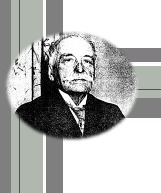


|
Main Page -Terms |
The stream-lining of how a kitchen is currently run, was an idea from Augustus Escofier. He's extremely famous in the Culinary History of the modern world. Anyway, he ran his kitchen like it was the military. Something that is still carried out today. Each area of the kitchen was given a name and a job fitting it's location to the ovens and cold storage. The baking area, of course, would be close to the ovens, as would the roasting station. These "stations" range from dessert and cold food prep, to deep fryers, and even a left over recycling work area. Since they were used and developed in classic french kitchens, the names and purposes are still used today.
The classic kitchen bridage had a station for everything, since they had no convenience food and had to make it ALL from scratch, while the modern brigade has been smoothed down to a skelleton crew of what it used to be. Let's go from top to bottom, shall we? See if you can translate the french word before I tell you the meanings. I bet you'll get it right more often then not.
Classic Kitchen Brigade
Chef du Cuisine
Escofier created a hierarchy of possitions and responcibilities. At the top of this list was the chef du cuisine or "Executive Chef" by today's names. He made sure all the operations and stations in the kitchen were going smoothly. He also developed the menu, related information and ideas to the owner of the restarant (provided he didn't own it) and is the over all figure head and leader of his kitchen.
Sous-Chef
Second in command, was the sous-chef. A large kitchen could have several sous-chefs. Back in the day, these guys were responcible for all kinds of things, but especially for placing each of the "lesser chefs" in their kitchen possisions. Sometimes they also made announcements for the Chef in charge, which would be an aboyuer (or announcer) but this also means "expediter." In today's kitchen world the expediter makes sure each plate leaving the kitchen looks beautiful.
Chef de Partie
Yes, this could be translated to a party chef, but not in reference to a nice evening out. The chef de partie was the head of his party or station in the kitchen. For example if the fry station has several people working in it, they answer to him. In return he answers to the sous-chefs.
Saucier
This poor bastard was in charge of all the sauted items coming out of the kitchen and most of the sauces each day. He had one of the hardest jobs there was, so naturally it took a while to work up to his status. Now-a-days there is a saucier (sauce/soup chef) who makes and keeps track of the sauces and soups, and the sauting is done by the line cooks, or the sauces and soups are made by the prep cooks early in the day.
Poissonier
Poisson ("Pui-saun" or "Pwe-saun" depending on who you ask) is french for fish. So the Poissonier doesn't spike the food with arsenic or try to escape from prison (haha), but they work with fish and seafood in the old kitches. They were even responcible for the sauces that go with it. It wouldn't be uncommon for the poor Saucier to take up this possition too. In modern kitchens the standard cooks would be doing shelfish, unless there was a major demand for it at that establishment.
Grillardin
The grill chef. This is harder than it sounds. This isn't a backyard bar-b-que. This chef had to know exactly when foods were perfectly grilled. To long and it's lost it's natural juices and moistness. Not long enough and it could make someone sick. This chef also cooks with the broiler and potentially the fried food.
Friturier
This person was responcible for all fried items. There may have been a large vat of lard back in the old days, that was over a constant heat and frying could have been done at any time. I believe the this word is a basis (or visa versa) of the french terms "fricasse" and "fritter" both fried items. Don't forget about pan frying! Last minute (A La Minute; "at the moment") fry jobs may have also been shoved off onto the saucier.
Rotisseur
This is the "roaster" chef, it can also refur to rotisory roasting and spit roasting. Not only did they prepare the meat, dress it, stuff it baste it, etc. But they also had to collect the drippings or jus (jue) and other related sauce materials. It wouldn't be unusual to adopt the roasting station with the grill and fry station and cooks.
Potager
"Pottage" is a term that refur to soups and brothy stuff. This low end chef made the stocks and sometimes soups. Also was a small assistant to the Saucier. Finally the man gets some relief. They did a lot of skimming of stocks and sauces as well as cutting a lot of veggies for the stocks they supervised, probably also preparing of various things the saucier would need, ie. sliced mushrooms, tomato concuse etc.
Legumier
The root veggies, starches, and most other veggies came from this man. Mashed potatoes? He's got it. Honey glazed carrots? Don't even have to ask! Yes the word "legume" is related to his possition.
Entremetier
This is an odd possition. Often times the Legumier and Potager would be combined into a single job or area. That was the Entremetier. On a similair note the courses served after the roast were called entremets and were usually made of sweet items and veggies, fruits and the like. Considering this course just came after a roast that probably had a starch and a few courses before that, these items had to be light on the palatte as well as the stomach and would usually be small. If you've ever had a sorbet or italian ice type thing after a course or a certain part of the meal, that's sort of a left over tradition of the entremets. It clears the palette for dessert or the next course.
Garde-Manger
Garde-Manger (gaurd-mon'zhay) is the art of the cold kitchen. It's also the Pantry chef. This person could save an establishment a truck load in money by recycling food. They picked through bones to look for usuable meat, snipped the unnused ends off of veggies to puree or use for decoration. Sausage was an art of theirs as well as small apertifs. The who idea of small orderves or appitizers came from their job. Were ever they could reuse something and turn it into a mouse or a crustini or some small piece of food and charge a lot of money for, was their responcibility. They also did fancy work, like decorating. A garde-manger chef for ice carvings and lovely melon carvings is more the common theme in modern kitchens. They have the job of delecate things, like back in the old days as well as giving them a top notch presitation. A lot of garde-manger work is done on buffets, or at least good ones. Sometimes the chef de garde-manger was the overseer of the boucher (butcher) who cut the meats and poultry.
Tournant
Tour-naut (tourist), is known as the roundsman or swing cook. He basically roams the kitchen and helps the cooks who needed it (I bet the saucier needed him a lot). This cook had to know a bit about everything to be able to help out.
Patissier
Could you guess this one? It's the Pastry chef. They held the responcibility for all baked items, including: breads, pasteries, cold desserts (icecreams) sweets and sweet creams for fillings or toppings. Often the bakery would be broken into a variety of jobs since baking is so intense. The Patissier was the chef du partie for the boulanger (bread baker), the confiseur (confectioner) who made candies, chocolates and small cakes like petite fours, the glacier who made cold and frozen desserts, and also the decoratuer (decorator) who would do a lot of show pieces and fancy stuff. It may include chocolate carvings, spun sugar, and a wide variety of other things. Now don't let these bakers through you off by being so low on the list. Often back then and continueing into today the bakers were in a totally differant catagory than cooks and chefs. Differant work differant principals and sometimes not getting along.
will continue